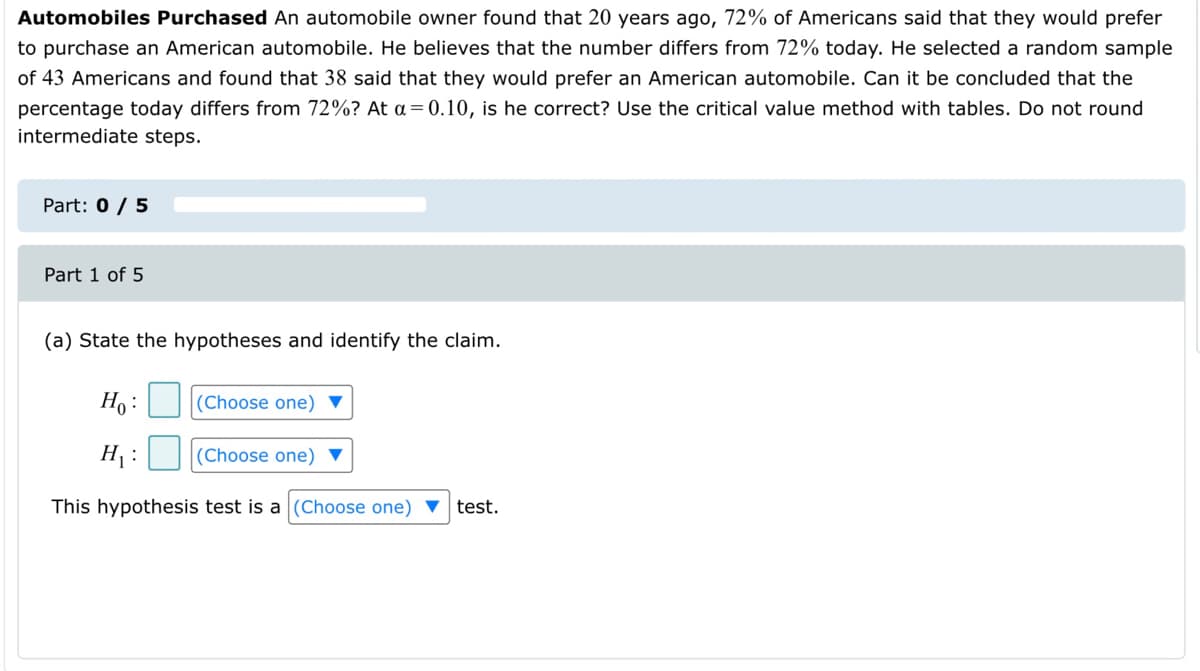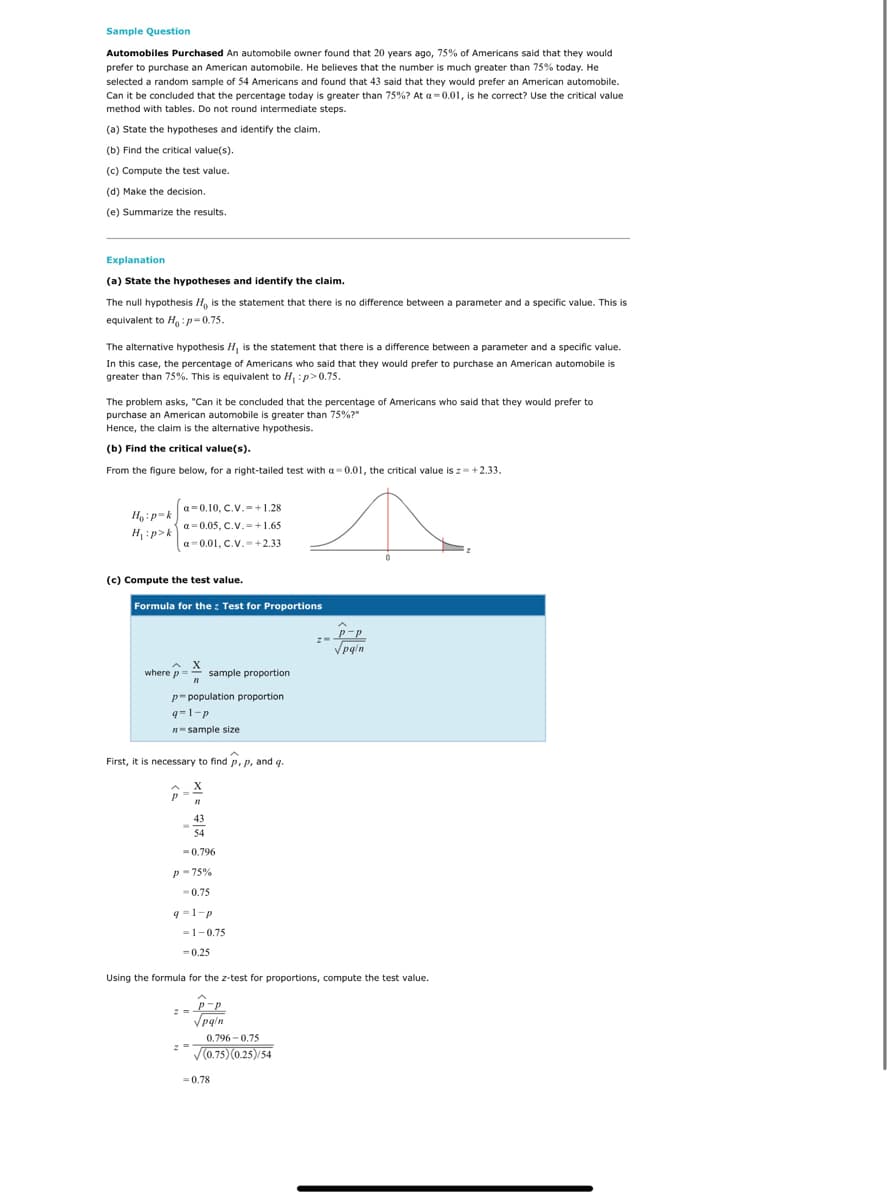Automobiles Purchased An automobile owner found that 20 years ago, 72% of Americans said that they would prefer to purchase an American automobile. He believes that the number differs from 72% today. He selected a random sample of 43 Americans and found that 38 said that they would prefer an American automobile. Can it be concluded that the percentage today differs from 72%? At a =0.10, is he correct? Use the critical value method with tables. Do not round intermediate steps. Part: 0 / 5 Part 1 of 5 (a) State the hypotheses and identify the claim. Ho : (Choose one) ▼ H : (Choose one) ▼ This hypothesis test is a (Choose one) ▼ test.
Automobiles Purchased An automobile owner found that 20 years ago, 72% of Americans said that they would prefer to purchase an American automobile. He believes that the number differs from 72% today. He selected a random sample of 43 Americans and found that 38 said that they would prefer an American automobile. Can it be concluded that the percentage today differs from 72%? At a =0.10, is he correct? Use the critical value method with tables. Do not round intermediate steps. Part: 0 / 5 Part 1 of 5 (a) State the hypotheses and identify the claim. Ho : (Choose one) ▼ H : (Choose one) ▼ This hypothesis test is a (Choose one) ▼ test.
MATLAB: An Introduction with Applications
6th Edition
ISBN:9781119256830
Author:Amos Gilat
Publisher:Amos Gilat
Chapter1: Starting With Matlab
Section: Chapter Questions
Problem 1P
Related questions
Question
The first pic is the question, since I’ve been receiving some incorrect answers from the tutors, I included an example problem in the second pic

Transcribed Image Text:Automobiles Purchased An automobile owner found that 20 years ago, 72% of Americans said that they would prefer
to purchase an American automobile. He believes that the number differs from 72% today. He selected a random sample
of 43 Americans and found that 38 said that they would prefer an American automobile. Can it be concluded that the
percentage today differs from 72%? At a = 0.10, is he correct? Use the critical value method with tables. Do not round
intermediate steps.
Part: 0 / 5
Part 1 of 5
(a) State the hypotheses and identify the claim.
Ho :
(Choose one) ▼
H :
(Choose one) ▼
This hypothesis test is a (Choose one) ▼ test.

Transcribed Image Text:Sample Question
Automobiles Purchased An automobile owner found that 20 years ago, 75% of Americans said that they would
prefer to purchase an American automobile. He believes that the number is much greater than 75% today. He
selected a random sample of 54 Americans and found that 43 said that they would prefer an American automobile.
Can it be concluded that the percentage today is greater than 75%? At a=0.01, is he correct? Use the critical value
method with tables. Do not round intermediate steps.
(a) State the hypotheses and identify the claim.
(b) Find the critical value(s).
(c) Compute the test value.
(d) Make the decision.
(e) Summarize the results.
Explanation
(a) State the hypotheses and identify the claim.
The null hypothesis H, is the statement that there is no difference between a parameter and a specific value. This is
equivalent to Ho:p=0.75.
The alternative hypothesis H, is the statement that there is a difference between a parameter and a specific value.
In this case, the percentage of Americans who said that they would prefer to purchase an American automobile is
greater than 75%. This is equivalent to H :p>0.75.
The problem asks, "Can it be concluded that the percentage of Americans who said that they would prefer to
purchase an American automobile is greater than 75%?"
Hence, the claim is the alternative hypothesis.
(b) Find the critical value(s).
From the figure below, for a right-tailed test with a- 0.01, the critical value is z-+2.33.
a=0.10, C.V.- +1.28
Ho:p=k
a=0.05, C.V.=+1.65
H:p>k
a-0.01, C.V.-+2.33
(c) Compute the test value.
Formula for the : Test for Proportions
Vpgln
A X
where p == sample proportion
p- population proportion
q=1-p
n- sample size
First, it is necessary to find p. p, and q.
43
54
-0.796
P- 75%
-0.75
9 =1-p
=1-0.75
= 0.25
Using the formula for the z-test for proportions, compute the test value.
Vpg'n
0.796 -0.75
V(0.75)(0.25)/54
= 0.78
Expert Solution
This question has been solved!
Explore an expertly crafted, step-by-step solution for a thorough understanding of key concepts.
This is a popular solution!
Trending now
This is a popular solution!
Step by step
Solved in 5 steps with 2 images

Recommended textbooks for you

MATLAB: An Introduction with Applications
Statistics
ISBN:
9781119256830
Author:
Amos Gilat
Publisher:
John Wiley & Sons Inc

Probability and Statistics for Engineering and th…
Statistics
ISBN:
9781305251809
Author:
Jay L. Devore
Publisher:
Cengage Learning

Statistics for The Behavioral Sciences (MindTap C…
Statistics
ISBN:
9781305504912
Author:
Frederick J Gravetter, Larry B. Wallnau
Publisher:
Cengage Learning

MATLAB: An Introduction with Applications
Statistics
ISBN:
9781119256830
Author:
Amos Gilat
Publisher:
John Wiley & Sons Inc

Probability and Statistics for Engineering and th…
Statistics
ISBN:
9781305251809
Author:
Jay L. Devore
Publisher:
Cengage Learning

Statistics for The Behavioral Sciences (MindTap C…
Statistics
ISBN:
9781305504912
Author:
Frederick J Gravetter, Larry B. Wallnau
Publisher:
Cengage Learning

Elementary Statistics: Picturing the World (7th E…
Statistics
ISBN:
9780134683416
Author:
Ron Larson, Betsy Farber
Publisher:
PEARSON

The Basic Practice of Statistics
Statistics
ISBN:
9781319042578
Author:
David S. Moore, William I. Notz, Michael A. Fligner
Publisher:
W. H. Freeman

Introduction to the Practice of Statistics
Statistics
ISBN:
9781319013387
Author:
David S. Moore, George P. McCabe, Bruce A. Craig
Publisher:
W. H. Freeman